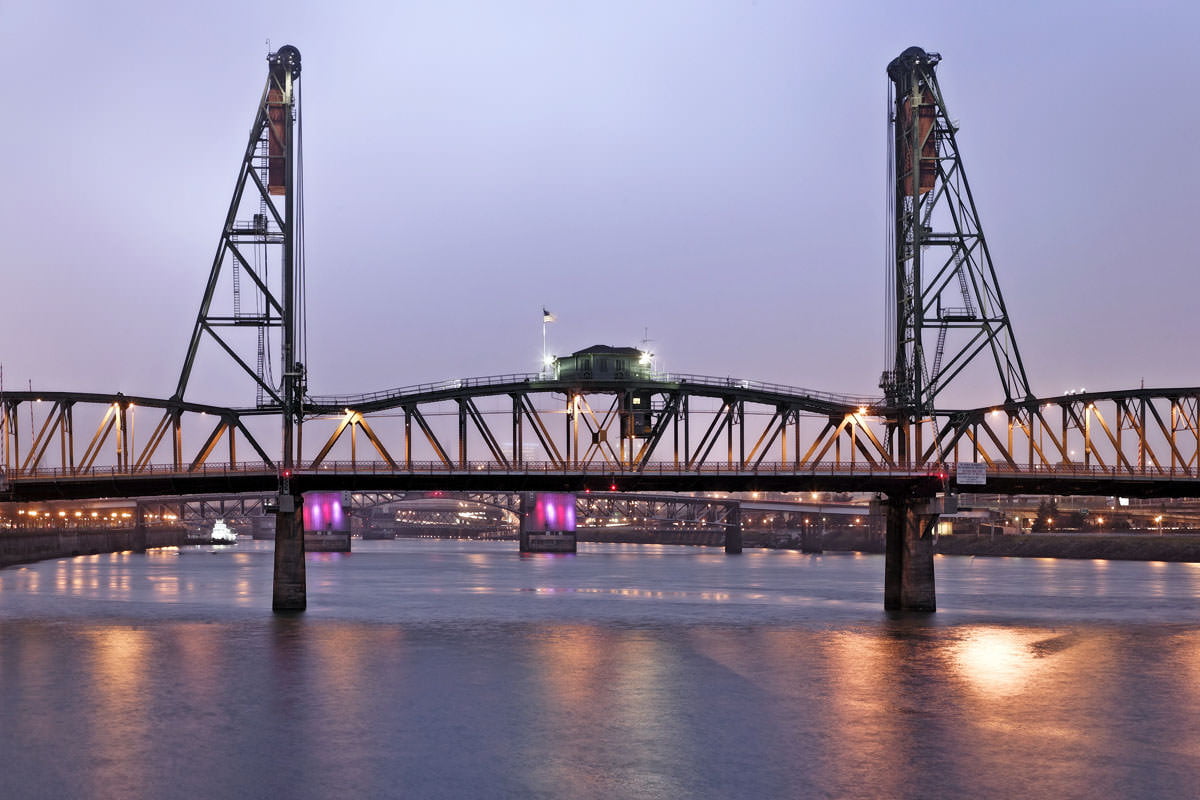
Bridge Stats
- Mile: 13.1
- Opened: Dec. 19, 1910; 1900; 1891
- Type: Vertical Lift
- Engineers/Designers: Waddell & Harrington (Kansas City, MO) Constructed by: Pennsylvania Steel Company of Portland
- Owner: Multnomah County
- Total Length: 1,383’
- Main strong Length: 244’
- Counterweights: (2 each) 440 tons (880,000 pounds)
- GPS Coordinates: 45.513284, -122.671301
WHAT THE WLB DID
To celebrate the 100th anniversary of the first transmission of electricity to Portland—June 2, 1889 from Oregon City to downtown Portland via the Hawthorne Bridge— Portland General Electric (PGE) stockholders proposed a “contribution to the community”. In the spring of 1989 they funded a temporary outlining of the Hawthorne Bridge’s arches, towers and railings with about 8,000 1.65-watt “beads” in clear plastic 20-ft. long tubes filled with silicon gel. WLB was happy to assist PGE with this “fairy lights” project. (This was, actually, the 2nd set of decorative lights for the Hawthorne; see our Hawthorne Bridge page for more of the Hawthorne’s history.)
ABOUT THE HAWTHORNE
The Hawthorne Bridge is the oldest operating vertical lift highway bridge in the USA. It has only 53′ clearance below deck at low water, so to permit river traffic–which has priority–its main span opens an average of 200 times a month and as often as 350 times during summer months.
Operating like a window sash, cables over pulleys slide the 244′ long movable span as much as 110′ up and down the 165′ high towers. The span’s weight is balanced by two 450-ton counterweights, one in each tower.
This historic bridge opened in 1910, the first of a series which replaced earlier Portland swing-span structures. It was constructed by the Pennsylvania Steel Co. of Portland for $511,216 and designed by world-renown, J.A.L. Waddell, (Waddell & Harrington, Kansas City, MO), inventor of the modern vertical lift bridge. It was named for James C. Hawthorne (1819-81), who was the first psychiatrist in the northwest when he moved to Oregon in 1859.
The bridge was built to accommodate pedestrian, horse, auto and street car crossings between downtown Portland and East Portland (The 2 cities had merged in 1895.). Even today its location and design make the Hawthorne Portland’s busiest bridge for pedestrians, bicyclists and public transit. The repainting and modifications project of 1998-99 included widening the sidewalks and strengthening the deck to better accommodate this multi-modal traffic.
The cabin mounted on the top of the lift span provides the bridge operator not only with controls for raising and lowering that span, but also a clear view of river and road traffic in all directions. It serves as “command center” for all four of Multnomah County’s movable bridges.
THE ARCHITECTURAL LIGHTS
Award-winning lighting designer Tony Adams–then of IDC, now owner of The Light Edge, in Lake Oswego–chose white floodlights to dramatize the Hawthorne’s dynamic qualities and distinctive, asymmetrical form. The “Lights-On” celebration was part of Portland Symphony’s concert finale at Waterfront Park on Sept. 2, 2004. Each night since lights mounted atop the north and south sides of each tower show off the dark green of the 165′ twin towers and the brick red of their 450-ton counterweights. (Miller Paints donated the red paint.) The floodlights also make the control cabin perched atop the often-elevated central span visible at night. No change was made to the street lights which illuminate the roadway and lower parts of the bridge structure and railings.
Adams other lighting projects include the Broadway Tower dome, OMSI, and the temporary Hawthorne design for PGE’s centennial (1989).


